News
The 2015 REVOLUTION Awards
News
The 2015 REVOLUTION Awards
Every year, we get together to argue over who gets to be inducted into our hall of fame. The 2015 REVOLUTION Awards is no exception, and without further ado, here are our picks for the greatest achievements and visionary individuals of the year.
FOUNDER’S CHOICE — Vacheron Constantin Historiques Cornes des Vache 1955
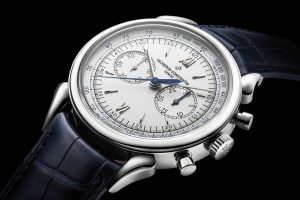 Perfection is an oft indiscreetly bandied-about term in the at-times-over-effusive lexicon of watch journalism. But it shouldn’t be. So that when you apply it to a watch — in this case, Vacheron Constantin’s 38.5mm Cornes de Vache with “cow horn” lugs — there’s an appropriate significance to it. Because the moment you lay your eyes on it, you will fall in love with it. Its sublime two-register countenance, the goldenratio-informed proportion of everything, from its pump pushers to its lugs and case size, and the way it sits on the wrist, is perfect.
Perfection is an oft indiscreetly bandied-about term in the at-times-over-effusive lexicon of watch journalism. But it shouldn’t be. So that when you apply it to a watch — in this case, Vacheron Constantin’s 38.5mm Cornes de Vache with “cow horn” lugs — there’s an appropriate significance to it. Because the moment you lay your eyes on it, you will fall in love with it. Its sublime two-register countenance, the goldenratio-informed proportion of everything, from its pump pushers to its lugs and case size, and the way it sits on the wrist, is perfect.
Even the movement beating within — the cal. 1142 (Vacheron Constantin’s equivalent of the Patek Philippe cal. CH27; both of these calibers being brand-specific movement references for in-house-modified versions of the venerable Lemania 2310, which Vacheron Constantin continues to use, thanks to a wonderful friendship between CEO Juan-Carlos Torres and the Swatch Group’s Marc A. Hayek, whose very architecture tells the story of timekeeping reaching back to the ’40s) — is perfect. And though it is ostensibly based on the legendary ref. 6087, the Cornes de Vache is entirely its own animal, made wonderfully contemporary by Emilie Vuilleumier, the same woman who designed Vacheron Constantin’s ref. 57260 pocket watch, the world’s most complicated timepiece.
REVOLUTIONARY WATCH — Vacheron Constantin Ref. 57260
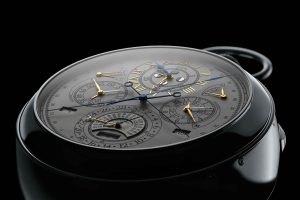 In the world of horology, there are two universal fascinations: the most expensive watches, and the most complicated. Records in these realms can intersect, as was the case with Patek Philippe’s famous Henry Graves Supercomplication, which has held both titles, and still holds one. Commissioned in 1925 and delivered in 1933 to the famed collector Henry Graves Jr., this pocket watch features 24 complications, making it for many years the most complicated, and it set the record for the most expensive watch sold at auction not once, but twice — in 1999 for about USD11 million, and again in 2014 for about USD24 million.
In the world of horology, there are two universal fascinations: the most expensive watches, and the most complicated. Records in these realms can intersect, as was the case with Patek Philippe’s famous Henry Graves Supercomplication, which has held both titles, and still holds one. Commissioned in 1925 and delivered in 1933 to the famed collector Henry Graves Jr., this pocket watch features 24 complications, making it for many years the most complicated, and it set the record for the most expensive watch sold at auction not once, but twice — in 1999 for about USD11 million, and again in 2014 for about USD24 million.
As timepieces become increasingly complex, the record for the number of complications has tended to move upward in small increments, as the challenge of blending increasing numbers of complications becomes ever more daunting. When Patek Philippe created the Caliber 89 more than 50 years after the Graves watch, it had 33 complications, and it contained an amazing 1,728 components.
Then along comes a once-in-a-lifetime achievement that causes us to recalibrate our concept of the possible. In the world of athletics, for example, running and jumping records tend to be broken by fractions of seconds and inches. Then in 1968, Bob Beamon improved on the long-jump world record by nearly two feet in a single go, establishing a mind-bending new benchmark.
A few months ago, Vacheron Constantin brought that type of moment to the world of watchmaking with the launch of the ref. 57260 — 57 indicates the number of complications (!), and 260 denotes the anniversary the achievement celebrates. The product of years of effort by three master watchmakers (see the Watchmaker of the Year Award), the ref. 57260 leapt well past the competition and into the record books, where it is likely to remain for some time.
Reduced to raw numbers, the immensity of Vacheron’s accomplishment is driven home: 2,826 components, 242 jewels, 85 prototypes, 57 complications (10 of which did not previously exist), 31 hands, 10 patents, eight years in the making, and one very lucky client. That’s not evolutionary, that’s revolutionary.
TECHNICAL ACHIEVEMENT — Harry Winston Opus 14
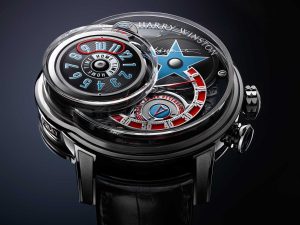 It is one thing to have an idea, and quite another to make it happen, as any watchmaker or constructor will tell you. Frank Orny and Johnny Girardin from Telos Watch had a crazy idea for a watch, one that they could never have turned into a reality on their own, but with the help of Harry Winston and the Blancpain Laboratory, they succeeded in creating an extraordinary piece of horological magic.
It is one thing to have an idea, and quite another to make it happen, as any watchmaker or constructor will tell you. Frank Orny and Johnny Girardin from Telos Watch had a crazy idea for a watch, one that they could never have turned into a reality on their own, but with the help of Harry Winston and the Blancpain Laboratory, they succeeded in creating an extraordinary piece of horological magic.
We are, of course, talking about the recently launched Opus 14 that has been nicknamed “the jukebox on your wrist”. It works using a stack of four discs with different displays — local time, GMT time, date, and a star bearing the signature of Mr. Harry Winston — that slide out like vinyl records in a jukebox on demand. It works thanks to a selector on the side of the case at nine o’clock. Once a specific display has been chosen, the entire stack of records moves up freeing the chosen disk. A gentle press on the pusher at four o’clock and an arm reaches out, picks up the disk and moves it onto the “turntable” on the dial at two o’clock. Every other element of the mechanism has been secured so that users can play with the mechanism without any risk of blocking or damaging the movement.
The movement features a base movement from Blancpain that was entirely tested in Blancpain’s laboratory throughout the development process, starting with the ideas, through to different blocks of the movement, and then the whole complication and the watch. Blancpain tests are known for their abuse and the Opus 14 endured forces of up to 500G.
Everyone can have good ideas, what’s uncommon are people who’ll work together to make them happen. “We are always stronger when we work as a team, and we had the help of Harry Winston and the Blancpain Laboratory,” shared Orny. With the Opus 14, the combined efforts of all these talents are proof that sometimes the wildest ideas can work, and the reason for this highly merited Revolution Award for Technical Achievement.
BEST COMPLICATION — Breguet Tradition Chronographe Indépendant Ref. 7077
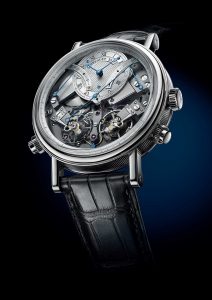 The Breguet Tradition Chronographe Indépendant 7077 was one of those watches that struck deeply when it was shown at Baselworld this year, and the understated nature of how it was revealed to the press was perhaps one of the factors that helped to underscore how amazing its complication was.
The Breguet Tradition Chronographe Indépendant 7077 was one of those watches that struck deeply when it was shown at Baselworld this year, and the understated nature of how it was revealed to the press was perhaps one of the factors that helped to underscore how amazing its complication was.
It looked, for all intents and purposes, like any one of the watches from the Tradition range, coming with its signature small subdial displaying hours and minutes at 12 o’clock, with the rest of the space showcasing the various details of its movement, laid bare for the world to admire. Yet it held two balance wheels mounted symmetrically at six o’clock, a clue perhaps to something quite different going on.
Essentially, the Chronographe Indépendant 7077 could be thought of as two complete watches in one, in which we define the parts for a complete watch being all members of the going train, from the balance wheel to the power source. Here, one going train is dedicated to chronograph timing, while the other is for timekeeping. This deviates from a standard chronograph then, where the chronograph going train takes timing impulses and power from the main gear train — while the chronograph gear train in this watch has its own extra balance wheel and — get this — a power source of a kind very rarely seen in watchmaking. Unlike the coiled mainspring we are familiar with, this chronograph is driven by a blade spring, an ingenious flexed mainspring that gets its power every time the watch is reset.
Totally independent from the mainspring in the timekeeping gear train, and made for optimum elasticity, this blade spring allows timing for up to 20 minutes. The moment of realization for a watch like this is one of those rare moments when one is astounded at the level of ingenuity it packs within — not just from how it functions, but also the very conception of such an idea in the first place. Indeed, when a brand like Breguet scarcely considers it necessary to make a fuss about such an astounding achievement, it might just be that doing something like this is so easy; they can do it with their eyes closed. However, for us, we were left speechless when we saw this watch — and there is no doubt that it deserves the award for the best complication of the year.
BEST DESIGN — Tudor Black Bay Black
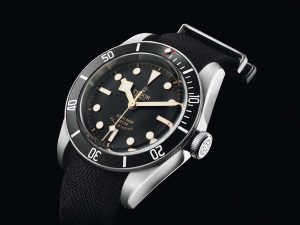 Blessed is the neologist who coined the term “no-brainer”, for the Tudor Black Bay Black is so obviously the perfect recipient of our Best Design award that it defines the term. It wasn’t merely an automatic choice: there simply was no way it couldn’t grab the kudos.
Blessed is the neologist who coined the term “no-brainer”, for the Tudor Black Bay Black is so obviously the perfect recipient of our Best Design award that it defines the term. It wasn’t merely an automatic choice: there simply was no way it couldn’t grab the kudos.
We knew months ago that this watch was special. Within seconds of Revolution UK editor Tracey Llewellyn (a hardcore Tudor fan whose vote counts as 10) first seeing the one-off Black Bay Black for the Only Watch auction, she wailed, “I want it! They absolutely have to make a production version of this!” And what the lady wants…
She called it like a veteran tipster at the races. Not only did Tudor deliver a Black Bay Black one-off for Only Watch that brought the hammer down at CHF375,000, setting an utterly incomprehensible world record for a Tudor — no, make that “apocalyptic” — but Tudor, is generously allowing mere mortals to enjoy the watch with only the slightest changes in details. After all, the lucky so-and-so who shelled out three-and-a-half big ones for what is a sub-£2,500 watch deserves to have his distinguishable from the production version.
The Black Bay Black is the third color variation of what many consider to be the best “retro diver” watch in a field that includes such masterpieces as the revived Oris Diver Sixty-Five, Blancpain’s Fifty Fathoms, assorted IWC Polarises and the stunning Longines Legend Diver. This genre — surely a worthy category for collectors who would rather not pay the prices now fetched by the originals — has all but been commandeered by Tudor with both the Black Bay and the Pelagos.
Born in 1954, the Black Bay Black possesses all the characteristics that define what makes a legible and practical watch for scuba divers, or even “mere” swimmers. A rotating bezel for instantly absorbed readings of the time remaining, superlative water resistance and automatic winding — it ticks all those boxes. But where it transcends its rivals is in the area of style: “OMG”, as the inarticulate would say. Yeah, the Black Bay Black is effin’ stunning.
BEST MEN’S WATCH — Hermès Slim d’Hermès
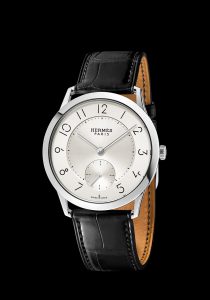 Four years ago, Philippe Delhotal, creative director of La Montre Hermès, stumbled across a beautifully designed timepiece from the 1950s in the maison’s archives. The elegance of this slim timepiece, while immediately catching his eye and attention, captured all the aesthetics and codes of the brand. A short while later, Delhotal was at Vaucher Manufacture, looking at different movements, when he was presented with a unique ultra-thin movement that had never been used before. Suddenly, these two separate encounters came together in his mind as a new collection. “When I saw the movement at Vaucher, I realized that both would go together perfectly; it was such luck,” explains Delhotal.
Four years ago, Philippe Delhotal, creative director of La Montre Hermès, stumbled across a beautifully designed timepiece from the 1950s in the maison’s archives. The elegance of this slim timepiece, while immediately catching his eye and attention, captured all the aesthetics and codes of the brand. A short while later, Delhotal was at Vaucher Manufacture, looking at different movements, when he was presented with a unique ultra-thin movement that had never been used before. Suddenly, these two separate encounters came together in his mind as a new collection. “When I saw the movement at Vaucher, I realized that both would go together perfectly; it was such luck,” explains Delhotal.
Creating a unique and simple new collection — with a round case, hours, minutes and date — is probably the hardest task for a watch designer. So Delhotal knew that the dial had to be something very special indeed. To create an original design, he asked graphic artist Philippe Apeloig to help him. Apeloig had worked for Hermès before and is credited with creating the visual identity of the brand’s Puiforçat and the 2013 Saut Hermès showjumping poster. Unfamiliar with watch design, Apeloig’s fresh approach resulted in a brand-new font for the dial that included perforations in the numerals and letters in different places, bringing a touch of modernity, originality and flair to this pure wristwatch. “The beauty of this watch is that it isn’t a revival timepiece; it was born from various encounters between the case, the movement and the dial,” shares Delhotal. “It is something that comes from inspiration.”
Named the Slim collection, there is a choice of gold or steel cases that measure 39.5mm in diameter and a super-slim 2.6mm in height, thanks to the inclusion of a discreet micro-rotor. La Montre Hermès’s knack for exquisite movements (Vaucher H1950 caliber for the date version and Agenhor for the perpetual calendar) and perfectly proportioned watches, made this an easy pick for Best Men’s Watch.
BEST WOMEN’S WATCH — Richard Mille Tourbillon Fleur
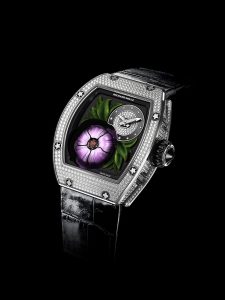 When it came to sifting through candidates for the best women’s watch of 2015, it was obvious that the past couple of years have witnessed a huge shift in direction. They may have taken their time, but manufactures have at last heard the screams from the 50 percent of the population who no longer want to be patronized with “one for the ladies”.
When it came to sifting through candidates for the best women’s watch of 2015, it was obvious that the past couple of years have witnessed a huge shift in direction. They may have taken their time, but manufactures have at last heard the screams from the 50 percent of the population who no longer want to be patronized with “one for the ladies”.
Yes, women may prefer elegance to the downright fugly, but until recently, there seems to have been a stubborn refusal to recognize what this actually means, leaving female watch buyers to filter through myriad gem-encrusted clones or to get down with the vintage and auction market. This year, however, several watches were in the running for this award — pieces that bridge the gap between tiny quartz cocktail watches and jumbo über-complications; watches designed and made specifically for women, but equal in every way to the mechanical and aesthetic attention afforded to men’s timepieces.
Although watches by brands old, new and reincarnated were considered, the hands-down winner of the Best Women’s Watch category was the Richard Mille Tourbillon Fleur. Along with very few other brands, Richard Mille has always paid equal attention to men’s and women’s timepieces, including its collaborations with Natalie Portman and Michelle Yeoh. With the RM 19-02 Tourbillon Fleur, the brand has upped its game again with a feature so entrancingly beautiful it could stop traffic in Piccadilly Circus.
Within the diamond-set, red- or white-gold 45.4mm-by-38.3mm case of the Tourbillon Fleur beats the cal. RM19-02 manual-winding movement with 36-hour power reserve, which gives accurate timekeeping via the hour-and-minute subdial at one o’clock. At seven o’clock, however, is the pièce de résistance: a hidden tourbillon nestled within a magnolia made of precious metals and lacquer. The magnolia’s five petals open gracefully either on demand via the pusher at nine o’clock or as a regular event every five minutes, revealing the mechanical secret at its heart.
Mille himself says the watch is “the creation of mimetic mechanical objects of art that imitate nature, thus blurring the dividing lines between artistic creativity and life itself”. Revolution can only agree with this master of stereotype-free horology.
BEST SPORTS WATCH — Audemars Piguet Royal Oak Concept Laptimer Michael Schumacher
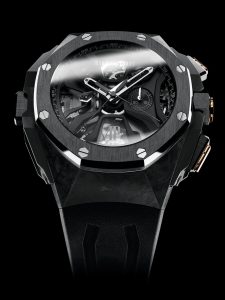 It was in the year 2010 when Michael Schumacher first asked Audemars Piguet if it would be at all possible to create a mechanical wristwatch, specifically for use in motorsport, to measure and record an extended series of consecutive lap times.
It was in the year 2010 when Michael Schumacher first asked Audemars Piguet if it would be at all possible to create a mechanical wristwatch, specifically for use in motorsport, to measure and record an extended series of consecutive lap times.
Audemars Piguet, of course, took up the challenge, and that’s not surprising, but the resulting watch — the answer they came up with to Schumacher’s question — will remain for a long time to come, simply unprecendented.
In essence, what Audemars Piguet has given the world with the Royal Oak Concept Laptimer Michael Schumacher, is both a split-seconds and flyback chronograph, built into one. We start off by activating the start pusher at two o’clock, like in most other chronograph watches. Press the pusher at four o’clock and the watch functions like most flyback chronographs, with an instantaneous reset. Now, press the pusher at nine o’clock, and discover a chronograph that is truly revolutionary.
The pusher at nine o’clock has been functionally termed the laptime pusher. When it is depressed while the chronograph is running, one of the two central hands stops and records the elapsed time, while the other flies back to zero to begin recording another lap. Press it again, and the first stationary hand flies back to zero to begin recording yet another period, while the second running hand now stops to show you the elapsed time. Press it again, and the series of functions repeats itself.
It took Audemars Piguet five years of technical research and development to produce a solution so elegant that even as a new variety of chronograph, it presents the average user with no necessary learning curve, and that’s just downright sexy. For all these reasons, and the fact that Audemars Piguet has successfully answered a specific challenge in motorsport, put forth by one of its greatest legends, we could think of no better timepiece to present with this year’s Revolution Best Sports Watch Award.
ULTIMATE VALUE — Jaeger-LeCoultre Geophysic True Second
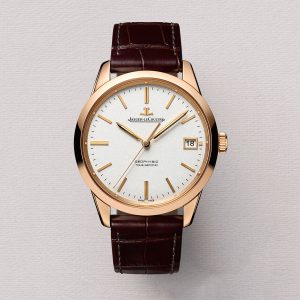 We often turn to Berner’s Illustrated Professional Dictionary of Horology to define key horological terms, yet it provides little guidance on the all-important concept of “value”. Some might say there are as many definitions of value as there are collectors. Yet there are some guideposts on which many will agree.
We often turn to Berner’s Illustrated Professional Dictionary of Horology to define key horological terms, yet it provides little guidance on the all-important concept of “value”. Some might say there are as many definitions of value as there are collectors. Yet there are some guideposts on which many will agree.
We often assign greater value to in-house movements, given the cost and know-how required to develop them. Upgrading from steel to gold increases actual and perceived value. New complications, groundbreaking technical developments and aesthetics found in six-figure timepieces don’t hurt.
A handful of brands have built up inherent value through many decades of groundbreaking efforts. Many value classic, never-out-of-style looks, and it’s nice when one glance at the dial tells you a watch is special. Perhaps above all else, we value the genuine icons for their respected, decades-old lineage.
Jaeger-LeCoultre’s Geophysic is a bona-fide icon produced by a revered brand known as the watchmaker’s watchmaker. The Geophysic watches strike so many chords: they are elegant tool watches created for a noble purpose, and behind the classic dials tick special movements used in watches supplied to the British Ministry of Defence.
Jaeger-LeCoultre’s True Second brings the Geophysic into the 21st century. Its all-new, high-watchmaking caliber incorporates the Gyrolab shaped balance based on the one used in the groundbreaking Master Compressor Extreme LAB. The movement’s bridges take the form of those found in the history-making Hybris Mechanica 11. The 18K-gold rotor is a first in a classic Jaeger-LeCoultre timepiece. The deadbeat seconds tell those in the know that this is a special timepiece.
Most brands launching a new watch at this level would offer it as a platinum or gold limited edition, and you could pick yours up in a couple of months, thank you very much. For the True Second, Jaeger-LeCoultre paved a new path that puts the clients first. The True Second is available in stainless steel, priced at USD9,050, and it was available for purchase on the day it was announced. Take note Mr. Berner — that is the definition of value.
WOMAN OF THE YEAR — Nayla Hayek
 Until recently, Nayla Hayek had been one of the more discreet members of the Swatch Group family, working behind the scenes in a number of different roles across the world, from board member to president of Balmain, and director of the Indian and Middle Eastern markets. But in May 2013, that all changed when she accepted the challenge of presiding over the illustrious Harry Winston marque, catapulting her onto the haute-horlogerie stage.
Until recently, Nayla Hayek had been one of the more discreet members of the Swatch Group family, working behind the scenes in a number of different roles across the world, from board member to president of Balmain, and director of the Indian and Middle Eastern markets. But in May 2013, that all changed when she accepted the challenge of presiding over the illustrious Harry Winston marque, catapulting her onto the haute-horlogerie stage.
Looking back over the last two-and-a-half years, it has become more and more apparent that this challenging leading-lady role was written for Nayla Hayek, as she continues to lead Harry Winston to incredible new heights. Collections such as the Histoire du Tourbillon, the Project Z, the Moonlight, the Avenue, the revolutionary Opus 14 (also a Revolution Award winner), among others, have proven her force as a brand leader.
During an interview with Revolution last year, we got a peek into her vision that couldn’t be further from your typical CEO: “I am proud of Swatch Group because it is my father’s baby, and I am proud of all the people at Swatch Group, who really are a family. It is not always easy because it is a different mentality. For me, the importance of what we do is to focus on the brands, the image of the brands, the DNA of the brands, and it isn’t about the person at the top. The person at the front of the picture has to be the brand,” she shared.
When she isn’t working, she loves to spend her time with her horses, far from the stardom and the diamonds: “I have to admit that I don’t normally wear big diamonds (laughs). I think it is nice to have some jewelry, but I don’t go to the stables with diamonds! The part I am enjoying the most is the challenge”— a challenge that she has embraced with grace and brilliance, and for that, she is our leading lady of the year.
BRAND OF THE YEAR — Montblanc
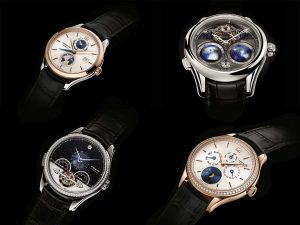 There’s no other way to put it: Montblanc has been absolutely killing it over the last couple of years, due to forceful leadership and a refreshed range of product offerings. We recognized this last year when we named Jérôme Lambert our Revolution Man of the Year, and we’re acknowledging the sustained juggernaut momentum of the brand in 2015 with this award.
There’s no other way to put it: Montblanc has been absolutely killing it over the last couple of years, due to forceful leadership and a refreshed range of product offerings. We recognized this last year when we named Jérôme Lambert our Revolution Man of the Year, and we’re acknowledging the sustained juggernaut momentum of the brand in 2015 with this award.
Creating a successful watch is hard enough — let alone creating a successful collection in consecutive years. Last year’s Heritage collection was impressively expanded this year with the introduction of the full Heritage Chronométrie range. This included the Quantième Complet and Quantième Annuel, solid and pragmatic complications for everyday use, and the exceptional ExoTourbillon Chronograph, which showcased the high-watchmaking expertise of the brand’s Villeret atelier in a robust and accessible form.
Montblanc also brought Villeret back into the spotlight with the Tourbillon Cylindrique Geosphères, increased the mid-complications segment within the feminine Bohème with the Moongarden (presented at Watches & Wonders) and premiered an insanely wearable world-time watch in the Heritage Spirit Orbis Terrarum.
Needless to say, all this came at price points that were perfectly calibrated for today’s marketplace. In terms of product, strategy and market approach, Montblanc has hit every note in a symphony that few brands ever get right. What more do you need? I feel like this award kind of explains itself.
WATCHMAKER OF THE YEAR — Jean-Luc Perrin, Micke Pintus and Yannick Pintus
For the first time since we started this particular award (which isn’t all that long, to be fair; we’ve only awarded it four times before this), the honor is going to three individuals instead of one. If you don’t know what these three incredible people have done to merit this recognition, you clearly haven’t really been paying attention to the watch scene.
Jean-Luc Perrin, Micke Pintus and Yannick Pintus are the technical triumvirate who developed the colossus of modern watchmaking — the Vacheron Constantin ref. 57260. In order to create this ultra-complicated showcase of horological virtuosity, the three watchmakers re-examined every detail, component and aspect of each function that was to appear in the pocket watch.
In many instances, they re-imagined the mechanical systems that we’ve taken as axiomatic and infallible over the last three centuries. Entirely new indications, such as the display of the date of Yom Kippur and the Metonic cycle were incorporated into the watch.
Actually, to call the ref. 57260 a watch of any description seems to me a peculiarly determined exercise in bathos — sort of like calling the sun “a really hot pile of hydrogen”. The ref. 57260 is a mechanical computer of astounding sophistication and complexity. It takes one constant — the half-swing of a balance wheel — and translates that into a multitude of values corresponding to the various indications of time and calendrical systems.
You know, the difference engine of Charles Babbage, the so-called “father of the computer”, did pretty much just one thing only, and it was about the size of a modest church organ. Think about that the next time you make an observation about the impractical size of the ref. 57260. It’d be a lot more impractical if it were the size of a church organ, I can tell you that for free.
We normally don’t share this information, but I think you should know that the nominations for this award were unanimous. Quickest round of voting I’ve ever seen in my life, even taking into consideration that one time we polled the guests of the 2015 Revolution party to see if we should open another 10 bottles of champagne. Bravo to Jean-Luc Perrin, Micke Pintus and Yannick Pintus!
LIFETIME ACHIEVEMENT — Walter Lange
With 2015 being the 200th anniversary of the birth of Ferdinand Adolph Lange, it certainly has been a significant year of celebration for A. Lange & Söhne. However, while much of the focus has been on the brand’s founder, this year’s Lifetime Achievement Award goes to the man who made it possible for us to even know about the proud history of Glashütte in the first place. The story of how A. Lange & Söhne was revived for the modern era is well known, as is its protagonist, Walter Lange, great-grandson of Ferdinand Adolph Lange.
This was a man who in effect stood as the bridge between the old A. Lange & Söhne before the war, and its modern incarnation, which came back into existence in the early ’90s. If not for Walter Lange, the great tradition of Glashütte would have been lost in the mists of time, and all the wondrous pieces from A. Lange & Söhne over the past 20 years, like the Lange 1, Datograph and Zeitwerk, would not have been created. How scary is it to even contemplate such a thought? Here, the notion of a lifetime achievement award takes on another dimension, for Walter Lange did not, as we would normally expect, do good things on a regular basis — instead his grand achievement was in the persistence and patience that he demonstrated, planning and waiting for the right moment when the ingredients would all come together, before taking a massive risk to restart his family brand.
At the age of 65, when mere mortals are looking to retire, he went back to Glashütte after the Berlin Wall fell, and proceeded to restore the glory of his great-grandfather’s name. Twenty-one years on from A. Lange & Söhne’s rebirth in 1994, we have much to be grateful for. Indeed, a Lifetime Achievement Award has never resonated so deeply, and the horological world has him to thank for the wondrous brand that is A. Lange & Söhne.












